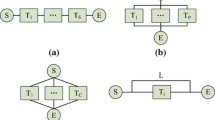Abstract
The Manufacturing cell design problem focuses on the creation of an optimal distribution of the machinery on a productive plant, through the creation of highly independent cells where the parts of certain products are processed. The main objective is to reduce the movements between this cells, decreasing production times, costs and getting other advantages. To find solutions to this problem, in this paper, the usage of the Flower Pollination Algorithm is proposed, which is one of the many nature-based algorithms, which in this case is inspired in the Pollination of the flowers, and has shown great capacities in the resolution of complex problems. Experimental results are shown, with 90 instances taken from Boctor’s experiments, where the optimum is achieved in all them.
Access this chapter
Tax calculation will be finalised at checkout
Purchases are for personal use only
Similar content being viewed by others
References
Storch, R.L.: Group technology. College of Engineering, University of Washington (2010)
Atmani, A., Lashkari, R., Caron, R.: A mathematical programming approach to joint cell formation and operation allocation in cellular manufacturing. Int. J. Prod. Res. 33(1), 1–15 (1995)
Adil, G., Rajamani, D., Strong, D.: A mathematical model for cell formation considering investment and operational costs. Eur. J. Oper. Res. 69(3), 330–341 (1993)
Kusiak, A., Chow, W.: Efficient solving of the group technology problem. J. Manuf. Syst. 6(2), 117124 (1987)
Purcheck, G.F.K.: A linear-programming method for the combinatorial grouping of an incomplete set. J. Cybern. 5(4), 51–78 (1975)
Medina, P.D., Cruz, E.A., Pinzon, M.: Generacin de celdas de manufactura usando el algoritmo de ordenamiento binario (aob). Scientia et Technica Ao XVI(44), 106–110 (2010)
Kusiak, A.: The part families problem in flexible manufacturing systems. Ann. Oper. Res. 3(6), 277–300 (1985)
Shargal, M., Shekhar, S., Irani, S.: Evaluation of search algorithms and clustering efficiency measures for machine-part matrix clustering. IIE Trans. 27(1), 43–59 (1995)
Seifoddini, H., Hsu, C.-P.: Comparative study of similarity coefficients and clustering algorithms in cellular manufacturing. J. Manuf.Syst. 13(2), 119–127 (1994)
Srinivasan, G.: A clustering algorithm for machine cell formation in group technology using minimum spanning tree. Int. J. Prod. Res. 32(9), 2149–2158 (1994)
Deutsch, S., Freeman, S., Helander, M.: Manufacturing cell formation using an improved p-median model. Comput. Ind. Eng. 34(1), 135–146 (1998)
Soto, R., Crawford, B., Almonacid, B., Paredes, F.: A migrating birds optimization algorithm for machine-part cell formation problems. In: Sidorov, G., Galicia-Haro, S.N. (eds.) MICAI 2015. LNCS (LNAI), vol. 9413, pp. 270–281. Springer, Heidelberg (2015). doi:10.1007/978-3-319-27060-9_22
Soto, R., Crawford, B., Almonacid, B., Paredes, F.: Efficient parallel sorting for migrating birds optimization when solving machine-part cell formation problems. Sci. Program. 2016 (2016). https://www.hindawi.com/journals/sp/2016/9402503/
Xambre, A.R., Vilarinho, P.M.: A simulated annealing approach for manufacturing cell formation with multiple identical machines. Eur. J. Oper. Res. 151(2), 434–446 (2003)
Yang, X.-S.: Nature-Inspired Metaheuristic Algorithms. Luniver Press, Bristol (2008)
Beni, G., Wang, J.: Swarm intelligence in cellular robotic systems. Adv. Sci. Lett. 102, 703–712 (1993)
Li, L., Shao, Z., Quian, J.: An optimizing method based on autonomous animals: fish-swarm algorithm. Syst. Eng. Theory Pract. 22(11), 32–38 (2002)
Oliveira, S., Ribeiro, J., Seok, S.: A spectral clustering algorithm for manufacturing cell formation. Comput. Ind. Eng. 57(3), 1008–1014 (2009)
Durn, O., Rodriguez, N., Consalter, L.: Collaborative particle swarm optimization with a data mining technique for manufacturing cell design. Expert Syst. Appl. 37(2), 1563–1567 (2010)
Shafer, S.M., Rogers, D.F.: A goal programming approach to the cell formation problem. J. Oper. Manag. 10(1), 28–43 (1991)
Aljaber, N., Baek, W., Chen, C.-L.: A tabu search approach to the cell formation problem. Comput. Ind. Eng. 32(1), 169–185 (1997)
Lozano, S., Daz, A., Egua, I., Onieva, L.: A one-step tabu search algorithm for manufacturing cell design. J. Oper. Res. Soc. 50(5), 209–516 (1999)
Wu, T., Chang, C., Chung, S.: A simulated annealing algorithm for manufacturing cell formation problems. Expert Syst. Appl: Int. J. 34(3), 1609–1617 (2008)
Acknowledgments
Ricardo Soto is supported by Grant CONICYT/FONDECYT/REGULAR/1160455, Broderick Crawford is supported by Grant CONICYT/FONDECYT/REGULAR/1140897, Rodrigo Olivares is supported by Postgraduate Grant Pontificia Universidad Católica de Valparaíso, Chile (INF-PUCV 2015), and Boris Almonacid is supported by Postgraduate Grant Pontificia Universidad Católica de Valparaíso, Chile (VRIEA-PUCV 2016 and INF-PUCV 2015), by Animal Behavior Society, USA (Developing Nations Research Awards 2016) and by Ph.D (h.c) Sonia Alvarez, Chile.
Author information
Authors and Affiliations
Corresponding author
Editor information
Editors and Affiliations
Rights and permissions
Copyright information
© 2016 Springer International Publishing AG
About this paper
Cite this paper
Soto, R. et al. (2016). Resolving the Manufacturing Cell Design Problem Using the Flower Pollination Algorithm. In: Sombattheera, C., Stolzenburg, F., Lin, F., Nayak, A. (eds) Multi-disciplinary Trends in Artificial Intelligence. MIWAI 2016. Lecture Notes in Computer Science(), vol 10053. Springer, Cham. https://doi.org/10.1007/978-3-319-49397-8_16
Download citation
DOI: https://doi.org/10.1007/978-3-319-49397-8_16
Published:
Publisher Name: Springer, Cham
Print ISBN: 978-3-319-49396-1
Online ISBN: 978-3-319-49397-8
eBook Packages: Computer ScienceComputer Science (R0)




